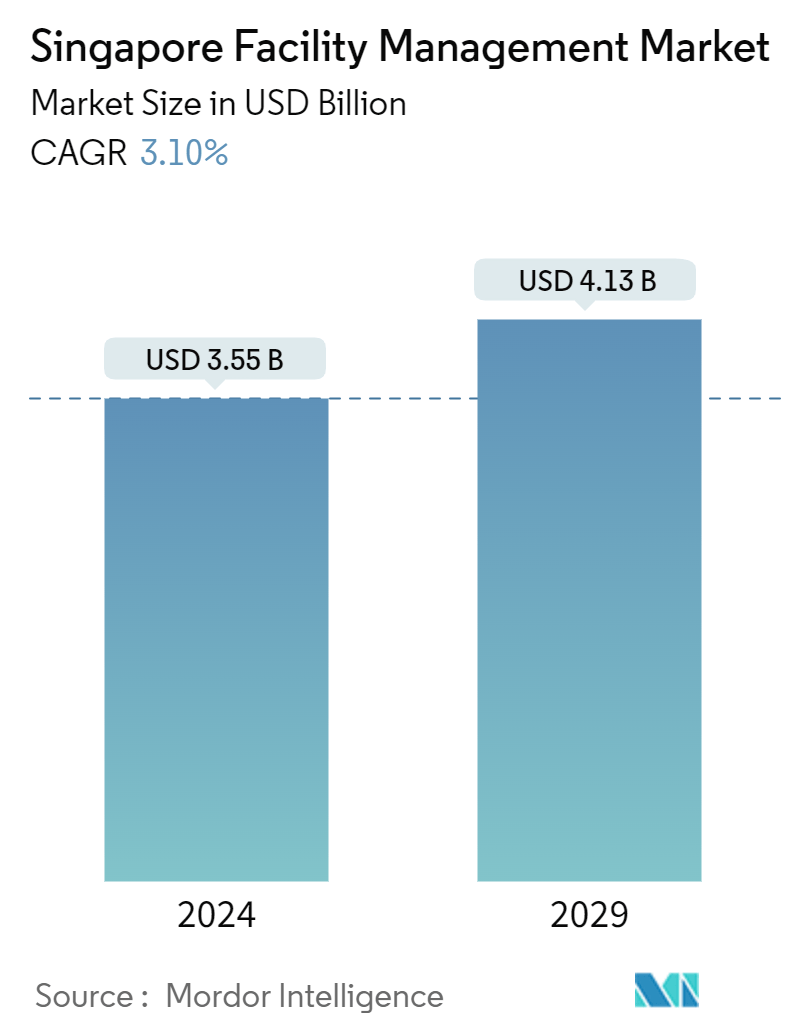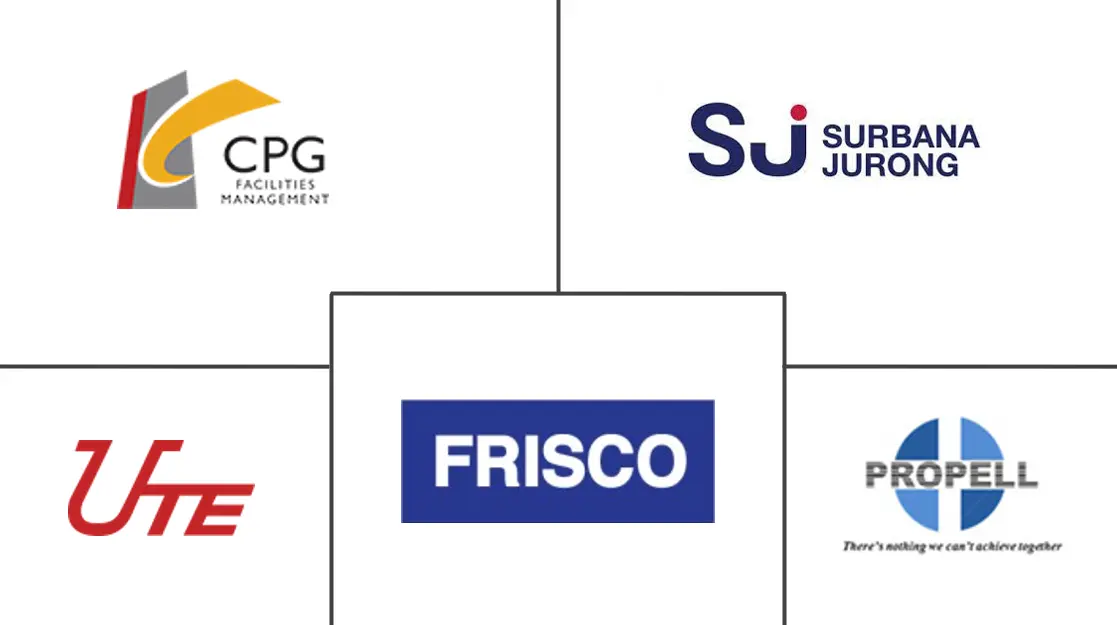Market Size of Singapore Facility Management Industry

| Study Period | 2019 - 2029 |
| Base Year For Estimation | 2023 |
| Market Size (2024) | USD 3.55 Billion |
| Market Size (2029) | USD 4.13 Billion |
| CAGR (2024 - 2029) | 3.10 % |
| Market Concentration | Medium |
Major Players
*Disclaimer: Major Players sorted in no particular order |
Singapore Facility Management Market Analysis
The Singapore Facility Management Market size is estimated at USD 3.55 billion in 2024, and is expected to reach USD 4.13 billion by 2029, at a CAGR of 3.10% during the forecast period (2024-2029).
- Facility management is a crucial function in an organization that harmoniously brings together individuals, physical spaces, and operational procedures within a constructed setting. Its primary objective is to enhance individuals' overall well-being and boost the productivity of the core business. By effectively managing various tasks, facility management facilitates the smooth collaboration of systems throughout the entire organization, from the parking lot to the executive suite. It guarantees the optimal functionality, comfort, safety, sustainability, and efficiency of the built environment.
- The expansion of the construction industry in Singapore is fueling the market's growth. This growth is primarily supported by the continuous strong growth in the public housing project pipeline, as the Housing Development Board (HDB) increases the supply of build-to-order (BTO) flats. The public sector demand is expected to be significantly influenced by industrial and institutional building construction, emphasizing water treatment plants, education buildings, and community clubs.
- In FY2023, the Singaporean construction sector made a substantial contribution of SGD 22.37 billion (~USD 16.89 billion) to the nation's GDP, marking a significant surge from its previous SGD 19.73 billion (~USD 14.89 billion) in FY2022, as reported by the Singapore Department of Statistics. This noteworthy growth comes after the construction industry faced considerable challenges due to the impact of the COVID-19 pandemic. With the increasing investments and advancements in construction, the adoption of facility management solutions is expected to increase. These solutions offer property owners greater returns compared to traditional real estate investments by providing management services and value-added offerings.
- As the demand for total facility management (TFM) rises, the public sector organizations in the country are progressively entrusting all non-core business functions to a single service provider, allowing them to concentrate more on their core operations. The anticipated growth in commercial real estate in the area is also expected to create opportunities for existing players facing challenges like market saturation.
- The utilization of intelligent systems integrated with sensors and artificial intelligence (AI) is becoming prevalent in numerous buildings throughout Singapore. This implementation aims to manage utilities and personnel effectively in response to rising costs. Additionally, these smart facilities management systems contribute to the promotion of environmentally friendly practices within buildings. As a result, the demand for facility management services has increased to oversee these new FM systems effectively. Companies like Sodexo have collaborated with Schneider Electric to introduce cutting-edge facility management services.
- FM remains a crucial component in the process of transitioning back to the workplace post-pandemic. Facility managers are ensuring that offices are adaptable to the changing needs of organizations and their evolving workforce while prioritizing the creation of safe and secure work environments. Moreover, the field of facility management is beginning to have an impact on environmental, social, and corporate governance matters. Additionally, the increasing development of infrastructure and smart cities nationwide is a key driver behind the increasing demand for facility management services in the market.
- Profit margins and the growth of current providers are being influenced by the intensifying market competition. The commoditization of FM services in the entire region is a result of the fierce rivalry among vendors. Global firms have been investing in entering the Singaporean FM market. Consequently, the demand for facility management services is expected to be disrupted by diminishing marginal profits caused by heightened competition and ongoing macro-environmental changes, thereby hindering the market's growth.
- The Singaporean facilities management market experienced a significant impact from the COVID-19 pandemic. Challenges such as a labor shortage, increased demand for FM services leading to a heavier workload, rising costs of providing FM services, and the need to stay updated with the latest advisories from relevant government agencies were faced by the industry during the pandemic.
Singapore Facility Management Industry Segmentation
Facility management includes various factors that impact organizational productivity and efficiency. FM includes management strategies and procedures for building management, infrastructure management for an organization, and general harmonization of an organization's work environment. This system standardizes services and streamlines operations for an organization.
The Singaporean facility management market is segmented by type, offering, and end user. By type, the market is segmented into in-house facility management and outsourced facility management [single FM, bundled FM, and integrated FM]. By offering type, the market is segmented into hard FM and soft FM. By end user, the market is segmented into commercial, institutional, public/infrastructure, industrial, and other end users. The market sizes and forecasts are provided in value (USD) for all the above segments.
| By Type of Facility Management Type | |||||
| In-house Facility Management | |||||
|
| By Offering Type | |
| Hard FM | |
| Soft FM |
| By End User | |
| Commercial | |
| Institutional | |
| Public/Infrastructure | |
| Industrial | |
| Other End Users |
Singapore Facility Management Market Size Summary
The Singapore Facility Management Market is poised for steady growth, driven by the expansion of the construction industry and the increasing demand for total facility management services. The public sector's focus on reducing costs and simplifying operations has led to a preference for bundled service contracts, which are expected to benefit from ongoing public spending cuts. The rise in commercial real estate and the adoption of intelligent systems in buildings are creating new opportunities for facility management services. These advancements are not only enhancing operational efficiency but also contributing to greener building practices. The market is experiencing a shift towards outsourcing non-core business activities to single service providers, allowing organizations to concentrate on their core functions.
The market landscape is characterized by significant competition, with global firms entering the Singapore FM market, leading to commoditization of services and pressure on profit margins. The COVID-19 pandemic posed challenges, including workforce shortages and increased service demands, but also highlighted the importance of adaptive facility management solutions. The commercial sector, encompassing various services such as property, cleaning, and security management, is witnessing growth due to the rising need for professional management in commercial spaces. Infrastructure development investments are further driving the demand for effective facility management services, as new projects require efficient maintenance and operation. The market is semi-consolidated, with key players engaging in strategic partnerships and technological innovations to enhance service offerings and address the evolving needs of clients.
Singapore Facility Management Market Size - Table of Contents
-
1. MARKET INSIGHTS
-
1.1 Market Overview
-
1.2 Industry Attractiveness - Porter's Five Forces Analysis
-
1.2.1 Bargaining Power of Suppliers
-
1.2.2 Bargaining Power of Buyers
-
1.2.3 Threat of New Entrants
-
1.2.4 Threat of Substitute Products
-
1.2.5 Intensity of Competitive Rivalry
-
-
1.3 Impact of the COVID-19 Pandemic on the Facility Management Market
-
-
2. MARKET SEGMENTATION
-
2.1 By Type of Facility Management Type
-
2.1.1 In-house Facility Management
-
2.1.2 Outsourced Facility Management
-
2.1.2.1 Single FM
-
2.1.2.2 Bundled FM
-
2.1.2.3 Integrated FM
-
-
-
2.2 By Offering Type
-
2.2.1 Hard FM
-
2.2.2 Soft FM
-
-
2.3 By End User
-
2.3.1 Commercial
-
2.3.2 Institutional
-
2.3.3 Public/Infrastructure
-
2.3.4 Industrial
-
2.3.5 Other End Users
-
-
Singapore Facility Management Market Size FAQs
How big is the Singapore Facility Management Market?
The Singapore Facility Management Market size is expected to reach USD 3.55 billion in 2024 and grow at a CAGR of 3.10% to reach USD 4.13 billion by 2029.
What is the current Singapore Facility Management Market size?
In 2024, the Singapore Facility Management Market size is expected to reach USD 3.55 billion.

